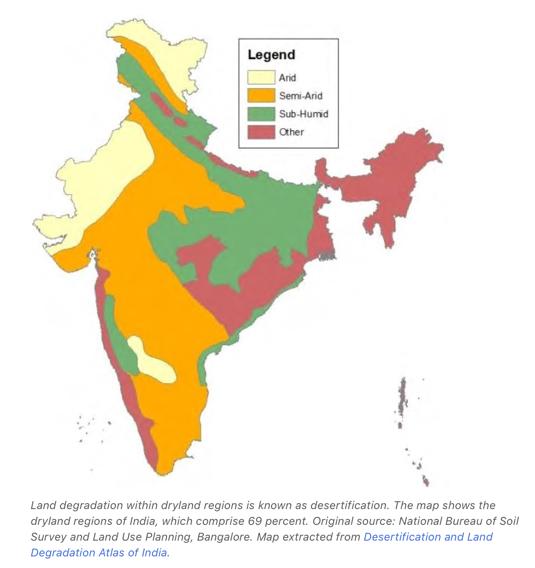| Demand of the question Introduction. What is land degradation? Body. Discuss reasons for increasing land degradation and desertification in India. Mention its impact. Conclusion. Way forward. |

Various reasons for increasing land degradation:
- Growing Demand: Growing demand for food, fodder, fuel and raw materials is increasing the pressure on land and the competition for natural resources. This has led to stress on land usage and has led to over-exploitation of land resources like overgrazing, and conversion to other land uses.
- Unsustainable agricultural practices: About 141 million hectares of land is used by agriculture in India. Faulty land and water management practices in agriculture have significantly contributed to land degradation. Intensive irrigation and high chemical use (fertilisers, pesticides, etc.) adds to degradation.
- Increasing population: With rise in population, stress on natural resources is increasing. People are looking to move into new areas and are invading new land in order to make houses. This is contributing to the rise in desertification and land degradation.
- Unplanned urbanisation: Economic development has led to expansion of urban and industrial land. Much of the present urban and industrial development has taken place on agricultural land. The expansion of cities has resulted in the encroachment of forest areas and wetlands. For example, rapid urbanisation triggered by a population increase in coastal areas has caused coastal land degradation.
- Climate Change: Climate change plays a huge role in desertification. As the days get warmer and periods of drought become more frequent, desertification becomes more and more eminent. Further rise in incidents like forest fires are destroying forests and leading to rise in desertification.
Various consequences of desertification:
- Reduction in agricultural productivity: Land degradation exacerbates climate change and threatens agricultural productivity. It reduces soil health, water quality and damages Thus in turn impact the livelihood of rural people.
- Water crisis: Land degradation has resulted in a deterioration in the quantity and quality of both surface and groundwater resources. Less vegetative cover leads to soil erosion. Runoff increases and flooding becomes more frequent and extensive. Groundwater recharge decreases, and the water table also drops.
- Endanger food resources: With land degradation, the food production is endangered and reduced. With reduced agricultural activities and productivity, land degradation endanger future nutrition.
- Decrease in population: Land degradation adversely impacts the population as it leads to increased health risk due to lack of nutrition and water. It reduces human settlement as land becomes non productive for livelihood. This would lead to internal and external migration.
Way forward:
- Afforestation: Forest degradation accounts for the major share of land degradation costs of India highlighting the need to prevent forest degradation. Further, strategy to reduce forest dependence for fuelwood, fodder and non-timber forest products should be made. Efforts must be made for afforestation.
- Using alternative fuels: A major focus for reducing forest degradation is encouraging rural households dependent on forests to switch to alternative fuel sources or at the minimum utilise fuel-efficient devices. The Ujjwala scheme is a positive measure but requires a relook to ensure its sustained uptake and success.
- Preventing overgrazing: Farmers should be discouraged from overgrazing activities. They must be made aware of the harmof overgrazing to land productivity.
- Sustainable agriculture: Climate resistant crops need to be developed and used. Efforts must be made to make farmers aware of overuse of chemical fertilisers. Subsidy may be removed for the same and replaced by Cash transfer.
As a signatory to the United Nations Convention to Combat Desertification (UNCCD), India is committed to reducing its land degradation and desertification. India’s goal is to achieve land degradation neutral status by 2030 whereby increases in land degradation would be offset by gains in land reclamation. The Green India Mission (GIM) under the National Action Plan on Climate Change is important that focuses on sustainable land management and restoration of degraded areas.





